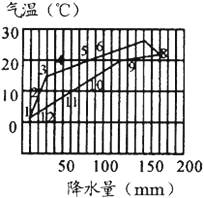读下图,完成下列小题(图中各数字代表该点的月份)

该图所代表的气候类型是()
A.地中海气候
B.温带季风气候
C.温带海洋性气候
D.亚热带季风气候
参考答案:D
解析:
该气候最低月气温高于0℃,为亚热带气候,最高月气温在7月,降水最多在夏季,故为亚热带季风气候。
考点:该题考查气候类型的判断和分布及其特征。
读下图,完成下列小题(图中各数字代表该点的月份)

该图所代表的气候类型是()
A.地中海气候
B.温带季风气候
C.温带海洋性气候
D.亚热带季风气候
参考答案:D
解析:
该气候最低月气温高于0℃,为亚热带气候,最高月气温在7月,降水最多在夏季,故为亚热带季风气候。
考点:该题考查气候类型的判断和分布及其特征。